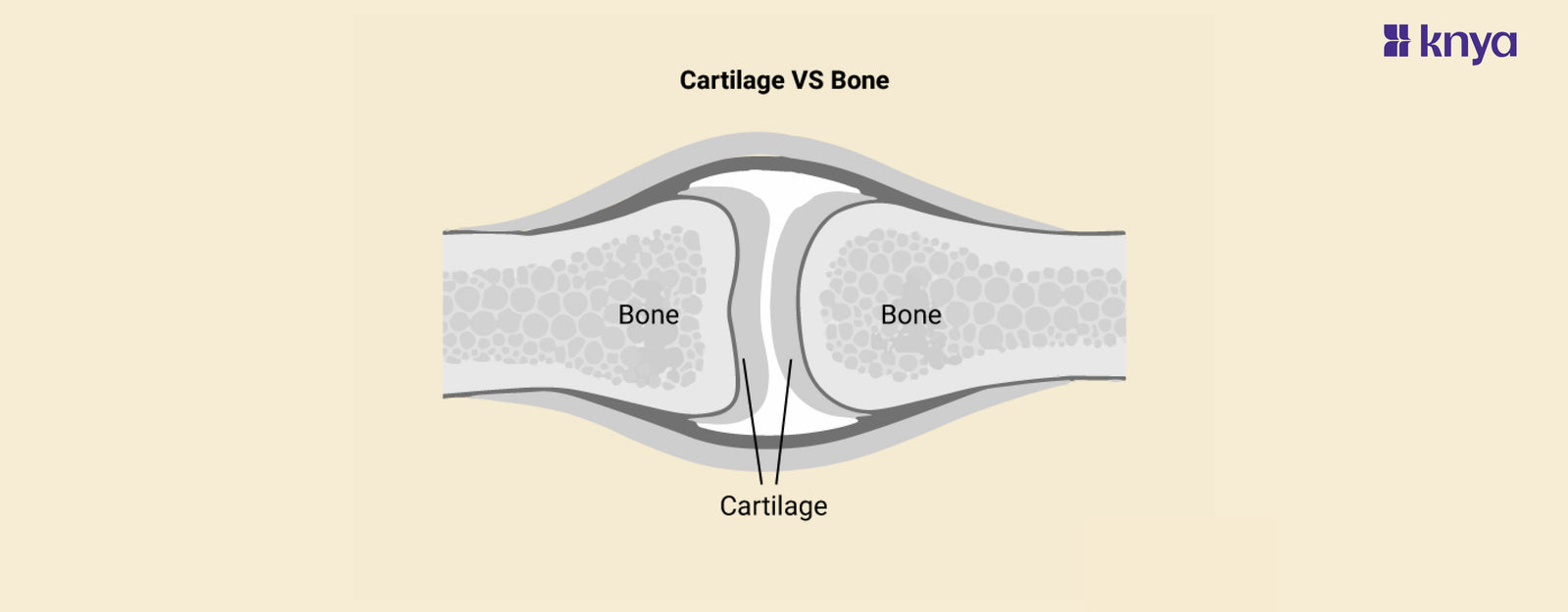Difference between Cartilage and Bone: Bone and Cartilage are two vital connective tissues, but play different roles. Bone is the hard, rigid framework, providing structure and support. It's rich in calcium, has blood vessels, and constantly remodels itself. Cartilage, softer and flexible, acts as a joint cushion and shock absorber. It lacks blood vessels and nerves, making repair slow but offering smooth, gliding surfaces for movement. Think of bone as the sturdy beams and cartilage as the shock-absorbing pads in your body's complex machinery.
Difference Between Cartilage and Bone
Both cartilage and bone, two essential building blocks of the body, work together to keep us moving and supported, but they differ in some key ways. Let's empower you guys with the difference between cartilage and bone.
|
Feature |
Cartilage |
Bone |
|
Composition |
Chondrocytes, collagen fibers, proteoglycans |
Osteocytes, collagen fibers, mineralized crystals |
|
Blood Supply |
Avascular, relies on diffusion for nutrients |
Highly vascularized, rich blood supply |
|
Flexibility |
More flexible |
Rigid and less flexible |
|
Growth |
Interstitial and appositional growth |
Appositional growth at the surface, growth plates |
|
Healing Capacity |
Limited regenerative capacity |
Robust healing capacity with proper care |
|
Types |
Hyaline, elastic, fibrocartilage |
Compact (cortical) and spongy (cancellous) bone |
|
Function |
Structural support, cushioning in joints |
Support, protection, movement, mineral reservoir |
|
Repair |
Challenging due to limited blood supply |
Involves callus formation, remodeling |
|
Calcification |
Does not undergo calcification |
Undergoes calcification for hardness |
|
Perichondrium/Periosteum |
Present in most cartilage types, aiding in nutrient diffusion |
Covered by a periosteum for growth and repair |
What is Cartilage?
Think of cartilage as the shock absorbers in your building. It's a smooth, elastic tissue that lines the ends of bones where they meet in joints. Cartilage acts like a spongy pad, absorbing impact and preventing bones from grinding against each other, which would be painful and damaging. It also helps keep your joints lubricated for smooth movement. Cartilage is found in many places besides joints, like your ears and nose, where it provides shape and support without needing the rigidity of bone.
Key Features of Cartilage:
- Unlike the rigidness of bone, cartilage bends and absorbs shock. consider it as the spongy padding between your vertebra, protecting them from wear and tear.
- Cartilage lines the ends of bones in joints, preventing friction and allowing smooth movement. Think of it as the slick surface on a playground slide, ensuring your ride is fun, not bumpy.
- Cartilage has no blood vessels, making it slow to repair and limited in its ability to grow and remodel. Once damaged, it's difficult to heal completely.
- Cartilage comes in three different types: hyaline (most common, found in joints), fibrocartilage (stronger with collagen fibers, found in discs between vertebrae), and elastic cartilage (flexible and bouncy, found in the ears and nose).
What is Bone?
Imagine your body as a building. Bones are the steel girders, providing the rigid framework that keeps everything upright and in place. They're incredibly strong, thanks to a mineral called calcium phosphate, and they come in all shapes and sizes, from the tiny bones in your inner ear to the long femur in your leg. Bones not only support your body weight but also protect your vital organs, like your brain and heart, and anchor your muscles for movement.
Key Features of Bone:
- Bone forms the hard framework of our body, providing unyielding support for muscles and protecting vital organs. It's like the sturdy steel beams holding up a building.
- Unlike cartilage, bone is constantly remodelled. Special cells break down old bone and build new bone, allowing for repair and adaptation. Think of it as a constantly updating blueprint, ensuring your skeleton stays strong and flexible.
- Bone is richly supplied with blood vessels, meaning it heals quickly and can grow and adapt throughout life. Imagine it as a well-nourished plant, constantly growing and changing.
- Bone comes in two main varieties: compact (dense and hard, found in the outer layer of bones) and spongy (less dense but lighter and shock-absorbing, found inside bones).
Shop Best Lab Coats from Here!
Similarities Between Cartilage and Bone
There might be various differences between Cartilage and Bone, but there are many similarities between those two.
- Both cartilage and bone are connective tissues.
- They provide structural support to the body.
- Collagen fibers are present in the extracellular matrix of both tissues.
- Both tissues are involved in the skeletal system.
- They contribute to the overall shape and form of the body.
- Both cartilage and bone play a role in joint function.
- They can be affected by various diseases and disorders.
- Both tissues have specialised cells (chondrocytes in cartilage and osteocytes in bone) responsible for maintaining the tissue.
- Both tissues are derived from embryonic mesenchyme.
- Cartilage and bone both contribute to the body's ability to withstand mechanical stresses.
Cartilage and bone are both connective tissues that provide support and structure to the body, but they differ in their texture, composition, and function. Bone is hard and rigid, while cartilage is soft and flexible. This difference is due to the composition of their extracellular matrices. Bone tissue is mineralized with calcium phosphate, which gives it its hardness. Cartilage, on the other hand, is made up of collagen fibers and proteoglycans, which give it its flexibility and resilience.
| Check out More Articles | |
| Difference Between Psychosis and Neurosis | |
| Dorsal Vs Ventral | |
| Difference Between Striated and Unstriated Muscles | |















